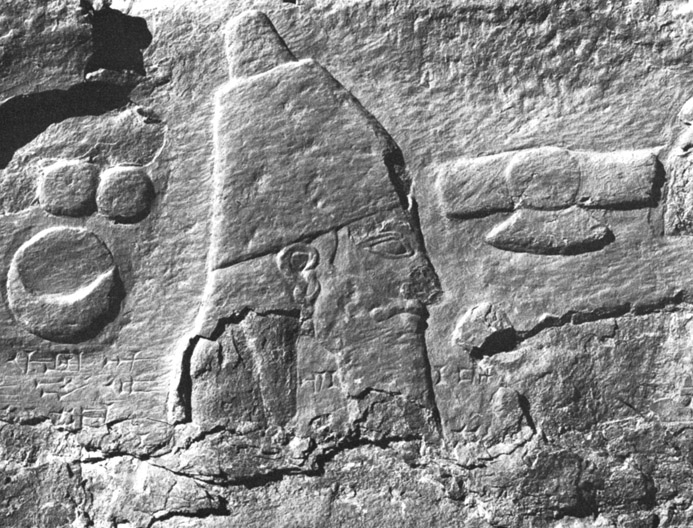|
Shikaft-e Gulgul
Shikaft-e Golgol-Gulgul (or Gulgulcave or Golgolcave) site is an Assyrian rock relief and inscription located in the vicinity of Gulgul, گل گل a village near Mount Pushta-e Kuh at Ilam in Iran. It was discovered by Louis Vanden Berghe (Ghent University, Royal Museums of Art and History, Brussels). The rock-carved relief is attributed to Esarhaddon. The sovereign depicted is wearing an Assyrian tiara, dressed in a tunic with only the feet appearing, and wearing earrings. He is armed with a sword, worn on a belt, and holding a mace in his left hand. The right arm is broken and seems to hold an object. On both sides of the king, divine symbols are represented. They include to the left; a full moon, the seven planets and the sun-disk symbol Ishtar. At right a winged disk and a horned tiara are identified as symbols of Shamash and Assyria Assyria (Neo-Assyrian cuneiform: , romanized: ''māt Aššur''; syc, ܐܬܘܪ, ʾāthor) was a major ancient Mesopotamian civilization w ... [...More Info...] [...Related Items...] OR: [Wikipedia] [Google] [Baidu] |
Assyria
Assyria (Neo-Assyrian cuneiform: , romanized: ''māt Aššur''; syc, ܐܬܘܪ, ʾāthor) was a major ancient Mesopotamian civilization which existed as a city-state at times controlling regional territories in the indigenous lands of the Assyrians from the 21st century BC to the 14th century BC, then to a territorial state, and eventually an empire from the 14th century BC to the 7th century BC. Spanning from the early Bronze Age to the late Iron Age, modern historians typically divide ancient Assyrian history into the Early Assyrian ( 2600–2025 BC), Old Assyrian ( 2025–1364 BC), Middle Assyrian ( 1363–912 BC), Neo-Assyrian (911–609 BC) and post-imperial (609 BC– AD 630) periods, based on political events and gradual changes in language. Assur, the first Assyrian capital, was founded 2600 BC but there is no evidence yet discovered that the city was independent until the collapse of the Third Dynasty of Ur in the 21st century BC, when a line of independent kin ... [...More Info...] [...Related Items...] OR: [Wikipedia] [Google] [Baidu] |
Sculpture Of The Ancient Near East
Sculpture is the branch of the visual arts that operates in three dimensions. Sculpture is the three-dimensional art work which is physically presented in the dimensions of height, width and depth. It is one of the plastic arts. Durable sculptural processes originally used carving (the removal of material) and modelling (the addition of material, as clay), in stone, metal, ceramics, wood and other materials but, since Modernism, there has been an almost complete freedom of materials and process. A wide variety of materials may be worked by removal such as carving, assembled by welding or modelling, or moulded or cast. Sculpture in stone survives far better than works of art in perishable materials, and often represents the majority of the surviving works (other than pottery) from ancient cultures, though conversely traditions of sculpture in wood may have vanished almost entirely. However, most ancient sculpture was brightly painted, and this has been lost. [...More Info...] [...Related Items...] OR: [Wikipedia] [Google] [Baidu] |
Assyrian Art And Architecture
The architecture of Mesopotamia is ancient architecture of the region of the Tigris–Euphrates river system (also known as Mesopotamia), encompassing several distinct cultures and spanning a period from the 10th millennium BC (when the first permanent structures were built) to the 6th century BC. Among the Mesopotamian architectural accomplishments are the development of urban planning, the courtyard house, and ziggurats. No architectural profession existed in Mesopotamia; however, scribes drafted and managed construction for the government, nobility, or royalty. The study of ancient Mesopotamian architecture is based on available archaeological evidence, pictorial representation of buildings, and texts on building practices. According to Archibald Sayce, the primitive pictographs of the Uruk period era suggest that "Stone was scarce, but was already cut into blocks and seals. Brick was the ordinary building material, and with it cities, forts, temples and houses were constructed. ... [...More Info...] [...Related Items...] OR: [Wikipedia] [Google] [Baidu] |
Buildings And Structures In Ilam Province
A building, or edifice, is an enclosed structure with a roof and walls standing more or less permanently in one place, such as a house or factory (although there's also portable buildings). Buildings come in a variety of sizes, shapes, and functions, and have been adapted throughout history for a wide number of factors, from building materials available, to weather conditions, land prices, ground conditions, specific uses, prestige, and aesthetic reasons. To better understand the term ''building'' compare the list of nonbuilding structures. Buildings serve several societal needs – primarily as shelter from weather, security, living space, privacy, to store belongings, and to comfortably live and work. A building as a shelter represents a physical division of the human habitat (a place of comfort and safety) and the ''outside'' (a place that at times may be harsh and harmful). Ever since the first cave paintings, buildings have also become objects or canvasses of much artis ... [...More Info...] [...Related Items...] OR: [Wikipedia] [Google] [Baidu] |
Rock Art In Asia
Rock most often refers to: * Rock (geology), a naturally occurring solid aggregate of minerals or mineraloids * Rock music, a genre of popular music Rock or Rocks may also refer to: Places United Kingdom * Rock, Caerphilly, a location in Wales * Rock, Cornwall, a village in England * Rock, County Tyrone, a village in Northern Ireland * Rock, Devon, a location in England * Rock, Neath Port Talbot, a location in Wales * Rock, Northumberland, a village in England * Rock, Somerset, a location in Wales * Rock, West Sussex, a hamlet in Washington, England * Rock, Worcestershire, a village and civil parish in England United States * Rock, Kansas, an unincorporated community * Rock, Michigan, an unincorporated community * Rock, West Virginia, an unincorporated community * Rock, Rock County, Wisconsin, a town in southern Wisconsin * Rock, Wood County, Wisconsin, a town in central Wisconsin Elsewhere * Corregidor, an island in the Philippines also known as "The Rock" * Jamaica, an isla ... [...More Info...] [...Related Items...] OR: [Wikipedia] [Google] [Baidu] |
Bit-Istar
Bit-Istar was an Assyrian town and a local kingdom (c. 12th century BC - c. 710 BC) at western Zagros that according to inscriptions of Tiglath Pileser III and Sargon II. It was located close to the source of a river to the east of Dyala. Stronach and Calmeyer proposed Ravansar as a possible candidate for the place of Bit-Istar. Recent surveys by Y. Hassanzadeh led to discovery of new evidence indicating presence of rich 1st-millennium remains close to the spring of Ravansar (). The ruler of this town during reign of Sargon II Sargon II (Neo-Assyrian cuneiform: , meaning "the faithful king" or "the legitimate king") was the king of the Neo-Assyrian Empire from 722 BC to his death in battle in 705. Probably the son of Tiglath-Pileser III (745–727), Sargon is general ... was Burburazu who brought his tributes to Sargon during his campaign to the region in 714 BC. A column base at the edge of Ravansar spring could belong to a temple that was built for Ishtar near "Water hole". ... [...More Info...] [...Related Items...] OR: [Wikipedia] [Google] [Baidu] |
Shamash
Utu (dUD "Sun"), also known under the Akkadian name Shamash, ''šmš'', syc, ܫܡܫܐ ''šemša'', he, שֶׁמֶשׁ ''šemeš'', ar, شمس ''šams'', Ashurian Aramaic: 𐣴𐣬𐣴 ''š'meš(ā)'' was the ancient Mesopotamian sun god. He was believed to see everything that happened in the world every day, and was therefore responsible for justice and protection of travelers. As a divine judge, he could be associated with the underworld. Additionally, he could serve as the god of divination, typically alongside the weather god Adad. While he was universally regarded as one of the primary gods, he was particularly venerated in Sippar and Larsa. The moon god Nanna (Sin) and his wife Ningal were regarded as his parents, while his twin sister was Inanna (Ishtar). Occasionally other goddesses, such as Manzat and Pinikir, could be regarded as his sisters too. The dawn goddess Aya (Sherida) was his wife, and multiple texts describe their daily reunions taking place on a mount ... [...More Info...] [...Related Items...] OR: [Wikipedia] [Google] [Baidu] |
Rock Relief
A rock relief or rock-cut relief is a relief sculpture carved on solid or "living rock" such as a cliff, rather than a detached piece of stone. They are a category of rock art, and sometimes found as part of, or in conjunction with, rock-cut architecture. However, they tend to be omitted in most works on rock art, which concentrate on engravings and paintings by prehistoric peoples. A few such works exploit the natural contours of the rock and use them to define an image, but they do not amount to man-made reliefs. Rock reliefs have been made in many cultures throughout human history, and were especially important in the art of the ancient Near East. Rock reliefs are generally fairly large, as they need to be in order to have an impact in the open air. Most of those discussed here have figures that are over life-size, and in many the figures are multiples of life-size. Stylistically they normally relate to other types of sculpture from the culture and period concerne ... [...More Info...] [...Related Items...] OR: [Wikipedia] [Google] [Baidu] |
Ishtar
Inanna, also sux, 𒀭𒊩𒌆𒀭𒈾, nin-an-na, label=none is an ancient Mesopotamian goddess of love, war, and fertility. She is also associated with beauty, sex, divine justice, and political power. She was originally worshiped in Sumer under the name "Inanna", and later by the Akkadians, Babylonians, and Assyrians under the name Ishtar, (occasionally represented by the logogram ). She was known as the "Queen of Heaven" and was the patron goddess of the Eanna temple at the city of Uruk, which was her main cult center. She was associated with the planet Venus and her most prominent symbols included the lion and the eight-pointed star. Her husband was the god Dumuzid (later known as Tammuz) and her , or personal attendant, was the goddess Ninshubur (who later became conflated with the male deities Ilabrat and Papsukkal). Inanna was worshiped in Sumer at least as early as the Uruk period ( 4000 BCE – 3100 BCE), but she had little cult activity before the conques ... [...More Info...] [...Related Items...] OR: [Wikipedia] [Google] [Baidu] |
Tiara
A tiara (from la, tiara, from grc, τιάρα) is a jeweled head ornament. Its origins date back to ancient Greece and Rome. In the late 18th century, the tiara came into fashion in Europe as a prestigious piece of jewelry to be worn by women at formal occasions. The basic shape of the modern tiara is a (semi-)circle, usually made of silver, gold or platinum, and richly decorated with precious stones, pearls or cameos. Tiaras were extremely popular during the late 19th century and were worn at events where the dress code was white tie. After World War I, wearing a tiara gradually fell out of fashion, except for official occasions at a royal court. Interest in tiaras has increased again since the beginning of the 21st century. The word "tiara" is often used interchangeably with the word "diadem". Description The basic shape of the modern tiara is a (semi-)circle, usually made of silver, gold or platinum. Tiaras have also been made from tortoiseshell, coral and quartz, and in ... [...More Info...] [...Related Items...] OR: [Wikipedia] [Google] [Baidu] |








